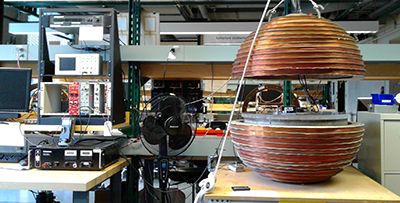In this section, Dr. Sean Robinson discusses the course re-design that has fundamentally shifted how students experience Junior Lab.
Rethinking “Sink-or-Swim”
"We hypothesized that some students were coming to our class and perhaps being pushed out of the profession, totally unintentionally on our part, simply because the course was teaching them that they were not the right type of person to be successful here."
Prior to 2012, Junior Lab was taught in a somewhat different format. It was still the case that students performed several experiments over the course of the semester and gave written papers and oral reports in the style of professional communications, but the first month of the course, during which we introduced them to the multiple skills students had to learn in order to perform experiments at a high level, was taught very differently.
The primary teaching method we used is what’s commonly known as “sink or swim.” We basically gave students some experiments to do, with the theory being that they would work as hard as they needed to in order to perform those tasks, and anyone who could complete those tasks was good enough to go on. To a certain extent, that was true. Students would get through those tasks, and then they would go on, and we’re very proud of the quality of the graduates that we were cultivating.
The drawback to that approach was how much time students were spending on those tasks and how much stress and anxiety they were causing students. To be certain, we want our students to struggle with our course material. We want them to have know that they have worked hard and they have been successful at something difficult. That, we believe, is a very important part of what constitutes an MIT physics education, and an MIT education in general.

Relativistic dynamics experiment equipment.
But we were finding, in practice, after talking to many students, alumni, colleagues in the physics department, and people who teach similar classes at universities across the country, that a lot of the struggle we were putting our students through was not useful to their learning. It was not helping them to see themselves as scientists, particularly when they were from demographics under-represented in the professional physics community, such as women, people of color, and first-generation college students.
We hypothesized that some students were coming to our class and perhaps being pushed out of the profession, totally unintentionally on our part, simply because the course was teaching them that they were not the right type of person to be successful here. We knew that students were learning lots of good physics, but at the same time, they were spending so much time and so much effort on it, and perhaps looking at some of their peers who were acting as if was “so easy,” and learning a lesson we really didn’t want them to be internalizing.
Flipping the Classroom
So after examining how students were performing in the class and getting feedback from students and alumni, we came to the conclusion that some minor changes in the introductory period of the class might be able to help remedy the problems we had identified. At the same time, massively open online courses (MOOCs) were becoming an active phenomenon in the teaching community, and it was just a lucky coincidence of timing. As MIT community members, we had access to the Residential MITx platform and tools we needed to implement flipped classroom techniques.
Our primary goal was to make the learning far more efficient so that students could get better quality learning in fewer hours. We thought if we could do that, then a lot of the other things we wanted to get done would fall into place. And overall, that has borne out over the past few years: we’ve increased the quality of the learning, while simultaneously decreasing the number of hours that students spend on it.
Our approach for achieving this was to take a lot of the direct instruction on things like data analysis out of lab time and, instead, use lab time for very high-yield educational, hands-on activities. We used flipped classroom techniques to make the direct instruction the homework, and then had class time for students to interact with experts who could support their active learning.
It took quite a bit of effort by about half a dozen or so instructors and students to make our existing content compatible with the Residential MITx platform. The process took roughly a year. The scale of the effort involved was akin to writing a textbook, even though we had all the content already developed. It was a challenge, but at the end of the day, we had a course where students could do preparatory work ahead of time, and come to class actually prepared to do the lab work.
The end result is that students are reporting many few hours per week spent on the class, yet their satisfaction with what they feel they are learning is much higher. Informally, the faculty who are teaching the class are much happier with the results they see from their students. It’s a pleasure to teach students who really know what they’re doing—and enjoy what they’re doing.










